Quantum computing in the Neanderthal books and real life
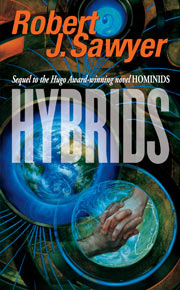
Robert J. Sawyer online:
Website • Facebook • Twitter • Newsgroup • Email
Labels: Hominids, Hybrids, Neanderthal Parallax
Library Journal on Wake: "Sawyer's erudition, eclecticism, and masterly storytelling make this a choice selection."

Robert J. Sawyer online:
Website • Facebook • Twitter • Newsgroup • Email
Labels: Hominids, Hybrids, Neanderthal Parallax
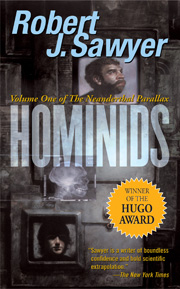
Everyone has heard about the asteroid that may have felled the dinosaurs, and how if it hadn't hit, we might not be here.Carolyn didn't like that much, and the next day, Friday, February 18, 2000, I completely revamped the opening:
But there have been many other asteroid impacts in Earth's past, and when this one crashed into Earth, the dinosaurs weren't yet even a twinkle in God's eye. If it hadn't hit, we would probably still be here, but they -- the others -- would not. This flying mountain, a hunk of detritus left over from the formation of the solar system that measured between one and three kilometers wide, brutally slammed into --
Into what? How to describe the rocks that bore this assault? Today, most of the world calls them the Canadian Shield, a vast horseshoe shaped region covering half the nation we refer to as Canada -- but when the impact occurred, Canada, and every other human construct, was still 1.8 billion years in the future.
Of course, in Canada, where everything would naturally be Canadian-this or Canadian-that, these rocks are sometimes called the Precambrian Shield instead, but --
But everything was Precambrian back when this colossal boulder, moving at fifteen kilometers per second, slammed into our world, setting it ringing like a giant bell in space. Although Earth had hosted life for two billion years by that point, none of it was yet multicellular. The first worms were another billion years in the future; jawless fish, the first vertebrates, were still 1.3 billion years away; and the first mammals -- ancestors to us, yes, and to them as well -- wouldn't appear for an additional three hundred million after that.
The darkness was absolute, more obsidian than Hitler's heart, darker than a rapist's soul.Of course, that lacked any character or drama. The final, published version of Hominids, which came out in 2002, began thus:
Two kilometers beneath the Earth's surface, the Sudbury Neutrino Observatory waited patiently. At its core was a vast acrylic globe twelve meters across, its walls 2.5 centimeters thick, filled with 1,100 tonnes of heavy water, on loan from Atomic Energy Canada Limited; the globe was made up of XX curved pieces each measuring XXX -- the largest size that could fit down the mine shaft leading to the observatory.
Surrounding that sphere was a geodesic of photomultiplier tubes -- 9,600 of them, each cupped in a reflective parabola, each aimed inward toward the sphere. And surrounding that was a giant barrel-shaped container, ten stories tall, filled with ultrapure regular water.
The two kilometers of Canadian shield overhead protected the heavy water from cosmic rays. The shell of regular water absorbed the natural background radiation from the uranium and thorium in the granite gabbro, preventing any of it from reaching the heavy water. Indeed, nothing at all could penetrate into the heavy water except neutrinos; trillions passed through the Earth every second, and any one of them could travel through a block of lead a light-year thick with only a fifty-percent chance of hitting anything.
Heavy water is just like regular water in taste (or lack thereof) and appearance, and it behaves virtually identically in most chemical reactions.
The blackness was absolute.You can read more of the published opening here.
Watching over it was Louise Benoît, twenty-eight, a statuesque postdoc from Montreal with a mane of thick brown hair stuffed, as required here, into a hair net. She kept her vigil in a cramped control room, buried two kilometers -- "a mile an' a quarder," as she sometimes explained for American visitors in an accent that charmed them -- beneath the Earth's surface.
The control room was next to the deck above the vast, unilluminated cavern housing the Sudbury Neutrino Observatory. Suspended in the center of that cavern was the world's largest acrylic sphere, twelve meters -- "almost fordy feet" -- across. The sphere was filled with eleven hundred tonnes of heavy water on loan from Atomic Energy of Canada Limited.
Enveloping that transparent globe was a geodesic array of stainless-steel struts, supporting 9,600 photomultiplier tubes, each cupped in a reflective parabola, each aimed in toward the sphere. All of this -- the heavy water, the acrylic globe that contained it, and the enveloping geodesic shell -- was housed in a ten-story-tall barrel-shaped cavern, excavated from the surrounding norite rock. And that gargantuan cavern was filled almost to the top with ultrapure regular water.
The two kilometers of Canadian shield overhead, Louise knew, protected the heavy water from cosmic rays. And the shell of regular water absorbed the natural background radiation from the small quantities of uranium and thorium in the surrounding rock, preventing that, too, from reaching the heavy water. Indeed, nothing could penetrate into the heavy water except neutrinos, those infinitesimal subatomic particles that were the subject of Louise's research. Trillions of neutrinos passed right through the Earth every second; in fact, a neutrino could travel through a block of lead a light-year thick with only a fifty-percent chance of hitting something.
Still, neutrinos poured out of the sun in such vast profusion that collisions did occasionally occur -- and heavy water was an ideal target for such collisions. The hydrogen nuclei in heavy water each contain a proton -- the normal constituent of a hydrogen nucleus -- plus a neutron, as well. And when a neutrino did chance to hit a neutron, the neutron decayed, releasing a proton of its own, an electron, and a flash of light that could be detected by the photomultiplier tubes.
At first, Louise's dark, arching eyebrows did not rise when she heard the neutrino-detection alarm go ping; the alarm sounded briefly about a dozen times a day, and although it was normally the most exciting thing to happen down here, it still didn't merit looking up from her copy of Cosmopolitan.
But then the alarm sounded again, and yet again, and then it stayed on, a solid, unending electric bleep like a dying man's EKG.
Robert J. Sawyer online:
Website • Facebook • Twitter • Newsgroup • Email
Labels: Hominids, Neanderthal Parallax
A minister wrote to me over the weekend to say it was a "cop-out" that my Neanderthals in Hominids and its sequels never had any religion; oh, he could understand a story about a kind of humanity that had turned away from religion, but not one that never had it; he said a lack of religion betrayed a fundamental lack of curiosity about their origins on their part. My reply:
Thank you for your very thoughtful letter.
Indeed, a man of the cloth might say it's a cop-out to not explain why the Neanderthals don't have religion and are incapable of the same leap you yourself have taken, but the point I was making was the opposite: the rational position based on looking at the evidence around you is that we're just here.
It is not a lack of curiosity to say that, and then try to fathom the random mechanisms -- from quantum fluctuations in a vacuum to evolution through natural selection -- that might have led to that; indeed, the lack of curiosity, if I may be so bold, is in positing some magical cause that requires no other explanation.
That is, rather than asking how do the Neanderthals possibly justify their lack of belief, the books ask how we possibly justify the presence of our belief. :)
Thanks again for taking the time to write me! I really appreciate it.
Robert J. Sawyer online:
Website • Facebook • Twitter • Newsgroup • Email

Due to the continued notable success of Hominids in mm paperback, we have not yet scheduled it in trade paper. The sales are too good to pass up in this market.Go, Ponter, go!
Visit The Robert J. Sawyer Web Site
and WakeWatchWonder.com
Labels: Hominids
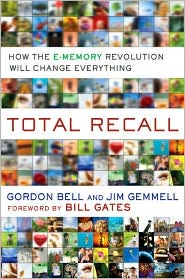
But themes of Total Recall have been explored in science fiction for decades. In Hominids, Robert J. Sawyer imagines the citizen of the future sporting a body-implanted "companion" computer that transmits information about his or her location, as well as three-dimensional images of exactly what he or she is doing, to an "alibi archive." The archive protects against false accusations.Needless to say, so far I'm quite enjoying the book!
Visit The Robert J. Sawyer Web Site
and WakeWatchWonder.com
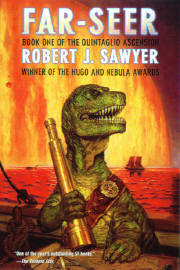
I picked up Far-Seer back when it first came out back in '92. I was intrigued by the cover and the concept.
<shame>It sat unread on my shelf until a couple of months ago.</shame>
I don't know why I never got around to it. No idea whatsoever. I just never did.
Flash forward (pun intended) to 2009, and the launch of the television series FlashForward. Was hooked on the series from the word go. <shame>But I was still clueless...</shame>
Walked into a bookstore near the end of October and saw a novel on the shelf titled FlashForward. "Gee, that was fast, they already have a novelization out.... oh, wait the series is based on the novel!"
Blew through the novel in a little over a week (given the limited time I have for reading for pleasure, less than a month is now considered "blowing through" a book), enjoyed it thoroughly, and have been wondering how the series (which seems to have a bit more of an action/adventure spin on the premise) is going to modify itself to fit on television - and leave an opening for a second season...
You could have knocked me over with a feather when I realized that the reason the name "Robert J. Sawyer" sounded so familiar was because I already owned a book by the same author... that I had been (passively) putting off reading for over a decade...
Knocked that one out in a couple of weeks too. And have been metaphorically kicking myself for not having read it sooner ever since. Then to find out it is the first in a trilogy...
I felt even more stupid when I discovered that I had read and greatly enjoyed "You See But You Do Not Observe" in a time travel anthology (I'm a sucker for time travel stories) several years ago and hadn't made the connection to Far-Seer.
When I got a gift certificate to a bookstore for Christmas/Hanukkah, I knew exactly what I was going to spend it on - whatever other Robert J Sawyer books they had on the shelf. Picked up Calculating God and Hominids.
A few minutes ago, I finished Hominids (having polished off Calculating God week before last). You've become the latest annual "addict my dad to yet another writer".
I really am intrigued by the dichotomy of the anti-theist stance of Far-Seer and the pro-theist stance of Calculating God and the anti-theist stance of Hominids. (I'm now suffering from theological whiplash. My existential insurance company will be sending you a bill...) As someone who feels strongly about the debate, I appreciate the way in which you handled both sides of the argument in each of the books. But even more, what I really like about your books (so far) is that the plot resolutions aren't so much about accomplishing something, or defeating something, as they are about healing the suffering of the characters.
As an American with a Canadian wife, I also appreciate the lack of US-centric thinking.
Great stuff! Thanks for writing it!
Visit The Robert J. Sawyer Web Site
and WakeWatchWonder.com
Labels: Calculating God, Far-Seer, Flashforward, Hominids

Mr. Sawyer.First, let's look at the passages in question:
I picked this book up at the library because I was intrigued by the premise of the storyline. I'm still intrigued by the concept, however, I found myself rolling my eyes at the insertion of your personal political views in and around the story.
I know it's your book and you can write what you wish, but you might find a broader fan base if you limited your story telling to ... well ... story telling.
Not all Canadians find capital punishment repugnant as you infer in this story. Not all Canadians subscribe to the assertion that Mike Harris decimated the health care system in Ontario. Personally, I believe it was the health care union workers who decimated health care in Ontario, but that happened decades before anyone ever heard of Mike Harris.
You definitely have a gift for writing and story telling. I enjoyed the fictional aspects of your book.
Regards.
"You know I'm delighted that he is well," said Singh, "but, really, I would like to discharge him. We don't have enough hospital beds as it is, thanks to Mike Harris." [31 words out of 100,000]And:
Mary's back stiffened. Like most Canadians, she was against capital punishment -- precisely because it was possible to execute the wrong person. All Canadians lived with the shame of the wrongful imprisonment of Guy Paul Morin, who had spent ten years rotting in jail for a murder he didn't commit; of Donald Marshall, Jr., who spent eleven years incarcerated for a murder he, too, didn't commit; of David Milgaard, who spent twenty-three years jailed for a rape-murder he also was innocent of. Castration was the least of the punishments Mary would like to see her own rapist subjected to -- but if, in her quest for vengeance, she had it done to the wrong person, how could she live with herself? And what about the Marshall case? No, it wasn't all Canadians who lived with the shame of that; it was white Canadians. Marshall was a Mi'kmaq Indian whose protestations of innocence in a white court, it seemed, weren't believed simply because he was an Indian. [165 words out of 100,000]Singh, the character making the comment in the first excerpt, is a medical doctor; thousands of doctors in Ontario (where Mike Harris was premier) would say exactly what Singh said. Under Mike Harris's administration 5,200 acute-care hospital beds were eliminated in Ontario.
Visit The Robert J. Sawyer Web Site
and WakeWatchWonder.com
Labels: Hominids

This book pushed everything to its limits, questioning morality, immorality, evil and good. It was confusing, irritating, annoying ... and yet it was also the most entertaining, and informative book I've read in a long time. It turned me around, upside-down, and made me love it. It's the kind of book I treasure the most because it reveals more about my world than in any classroom and ask questions on ideas I thought to be hard-grained truths. No doubt, my grandmother would burn it. Wonderful.
Visit The Robert J. Sawyer Web Site
and WakeWatchWonder.com

Visit The Robert J. Sawyer Web Site
and WakeWatchWonder.com
Labels: foreign rights, Hominids

Visit The Robert J. Sawyer Web Site
and WakeWatchWonder.com
Labels: Hominids, Neanderthal Parallax

Visit The Robert J. Sawyer Web Site
and WakeWatchWonder.com
Labels: Hominids, Humans, Hybrids, Neanderthal Parallax, Reviews
Fascinating article about, among other things, Homo sapiens dining on Homo neanderthalensis in Britain's Daily Mail.
Visit The Robert J. Sawyer Web Site
and WakeWatchWonder.com
Labels: Hominids

At what point in your creative process did you decide that Wake et al., would be a trilogy? And was it the same point for your first trilogy (or 2nd) or was the first one more of the publisher's choice (as in "this is too long to publish as a single novel; let's break it up into a trilogy")?My answer is might be of interest to other writers, so I'm sharing it here:
Has your plotting evolved over time to be more aware of this sort of thing?
The Robert J. Sawyer Web Site
Labels: Far-Seer, Hominids, Neanderthal Parallax, Publishing, Wake, Writing

The Robert J. Sawyer Web Site
Labels: Hominids, Neanderthal Parallax

The Robert J. Sawyer Web Site
Labels: Flash Forward, Flashforward, Hominids, Humans, Hybrids, Neanderthal Parallax
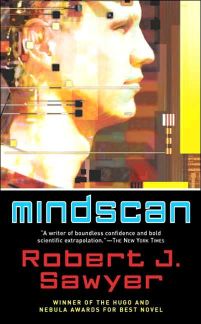
I sometimes include a bibliography. The one from my novel Hominids (Hugo winner, 2003; Tor Books) is online here.
And the one from my novel Mindscan (John W. Campbell Memorial Award winner, 2006; Tor Books) is online here.
But it's hardly a new practice. For instance, the horror novel The Night Stalker by Jeff Rice, basis for the Kolchak movies and TV series, first published in 1973, has an extensive bibliography (mostly about vampirism) including, cutely, a couple of made-up citations attributed to one of the characters.
The Robert J. Sawyer Web Site

The Robert J. Sawyer Web Site